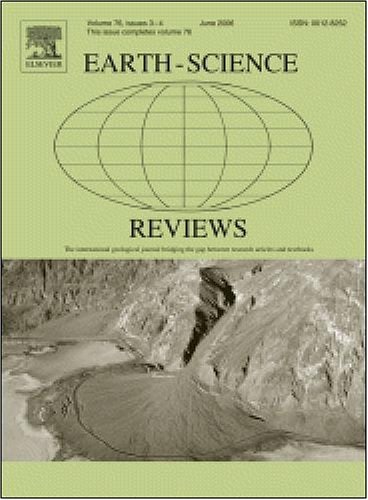Gaseous hydrocarbons cracking in shale: Mechanism, impact and resource significance
IF 10
1区 地球科学
Q1 GEOSCIENCES, MULTIDISCIPLINARY
引用次数: 0
Abstract
Gaseous hydrocarbons (C1 − C5) are the primary components of shale gas. Their thermal degradation significantly impacts various aspects of shale gas reservoirs, including gaseous hydrocarbons composition and their carbon and hydrogen isotopes fractionation, H2 generation, reservoir overpressure, mineral dissolution and brittle mineral formation, changes in reservoir properties and storage space, as well as the formation and identification of resource sweet spots. This study reviews the experimental simulations of gaseous hydrocarbon cracking and the geochemical research on major global shale gas reservoirs conducted over the past few decades. In shale gas reservoirs, C5H12, C4H10, C3H8, C2H6 and CH4 initiate cracking at Ro values of approximately 1.0 %, 1.0 %, 1.3 %, 1.5 %, and 2.0 %, respectively, with main cracking stages occurring at Ro ranges of 1.7–2.4 %, 1.7–2.8 %, 1.8–3.2 %, 1.8–3.6 %, and 3.0–4.0 %. This cracking produces more gaseous molecules, significantly contributing to overpressure and H2 in high-overmature reservoirs. Wet gas cracking contributes carbon isotope rollover but CH4 cracking causes both carbon and hydrogen isotope reversals in shale gas. As CH4 cracking onset marks peak gas generation of shale, carbon isotope reversal serves as a key sweet-spot indicator. Furthermore, hydrous pyrolysis of gaseous hydrocarbons generates formic and acetic acids that enhance porosity and permeability by dissolving carbonate and feldspar minerals. Concurrent silica precipitation during feldspar dissolution promotes quartz formation, improving reservoir fracturability. This study advances our understandings of the formation, evolution and associated geological and geochemical anomalies of shale gas reservoirs, which holds significant implications for the exploration and exploitation of shale gas resources.
页岩气烃裂解:机理、影响及资源意义
气态烃(C1 ~ C5)是页岩气的主要成分。它们的热降解作用显著影响页岩气储层的各个方面,包括气态烃组成及其碳氢同位素分馏、H2生成、储层超压、矿物溶解和脆性矿物形成、储层物性和储集空间的变化以及资源甜点的形成和识别。本文综述了近几十年来全球主要页岩气储层裂解实验模拟和地球化学研究进展。页岩气储层中,C5H12、C4H10、C3H8、C2H6和CH4在Ro值分别约为1.0%、1.0%、1.3%、1.5%和2.0%时开始裂解,主要发生在Ro值为1.7 ~ 2.4%、1.7 ~ 2.8%、1.8 ~ 3.2%、1.8 ~ 3.6%和3.0 ~ 4.0%时。这种裂解会产生更多的气体分子,显著增加了高过成熟储层的超压和H2。湿气裂解导致页岩气碳同位素翻转,而CH4裂解导致页岩气碳、氢同位素翻转。CH4裂解起始标志着页岩气生成峰值,碳同位素反转是关键的甜点指标。此外,气态烃的加氢热解产生甲酸和乙酸,通过溶解碳酸盐和长石矿物来提高孔隙度和渗透率。长石溶解过程中石英的同时沉淀促进了石英的形成,提高了储层的可压裂性。该研究促进了我们对页岩气储层形成、演化及相关地质地球化学异常的认识,对页岩气资源的勘探开发具有重要意义。
本文章由计算机程序翻译,如有差异,请以英文原文为准。
求助全文
约1分钟内获得全文
求助全文
来源期刊

Earth-Science Reviews
地学-地球科学综合
CiteScore
21.70
自引率
5.80%
发文量
294
审稿时长
15.1 weeks
期刊介绍:
Covering a much wider field than the usual specialist journals, Earth Science Reviews publishes review articles dealing with all aspects of Earth Sciences, and is an important vehicle for allowing readers to see their particular interest related to the Earth Sciences as a whole.
 求助内容:
求助内容: 应助结果提醒方式:
应助结果提醒方式:


